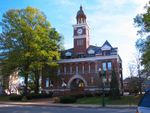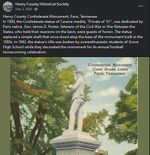Paris, Tennessee: Difference between revisions
imported>Pat Palmer (→Slavery at the time of the civil war: starting this section) |
imported>Pat Palmer |
||
| Line 21: | Line 21: | ||
== Slavery at the time of the civil war == | == Slavery at the time of the civil war == | ||
In the decade leading up to the civil war, most of the economy of Henry County came from moderate-sized farms between 20 and 500 acres; their owners and families were the main demographic of the county at that time.<ref>WTHS, Van Dyke p 72<ref>. Three other groups existed in small pockets only: large plantation owners, poor whites, and free negroes. Per the county census figures, a third of all heads of these farm families owned slaves in 1950. | In the decade leading up to the civil war, most of the economy of Henry County came from moderate-sized farms between 20 and 500 acres; their owners and families were the main demographic of the county at that time.<ref>WTHS, Van Dyke p 72</ref>. Three other groups existed in small pockets only: large plantation owners, poor whites, and free negroes. Per the county census figures, a third of all heads of these farm families owned slaves in 1950. | ||
Tobacco and cotton were main crops, and most of the labor for those crops was done by slaves, who constituted a quarter of the overall population at that time, but belonged to only about a third of the farm owners<ref>WTHS, Van Dyke pp69-71</ref>. The a third of farms owned slaves, two-thirds of Henry County voters elected to secede from the union, and any Northern sentiment was brutally suppressed<ref>WTHS Van Dyke, p 73 and p 78</ref>. | Tobacco and cotton were main crops, and most of the labor for those crops was done by slaves, who constituted a quarter of the overall population at that time, but belonged to only about a third of the farm owners<ref>WTHS, Van Dyke pp69-71</ref>. The a third of farms owned slaves, two-thirds of Henry County voters elected to secede from the union, and any Northern sentiment was brutally suppressed<ref>WTHS Van Dyke, p 73 and p 78</ref>. | ||
Revision as of 12:42, 4 February 2021
Authors [about]:
join in to develop this article! |
Paris, Tennessee (USA) is a small town of about 10,000 people in West Tennessee. It was founded and incorporated in 1823. Paris is in the geographic center of Henry County (which has 32,363 residents in 2021, including Paris[1]). The county is in the upper right corner of West Tennessee bordered by Kentucky (north) and the Tennessee River (east), and Paris, being in the center, is the county's legal and administrative seat. As is common in this region, the heart of the town and country is a "court square", a special city block on which stands an imposing court house. The current Henry County court house building dates from 1897[2].
Standing on the courthouse lawn is a statue of an anonymous confederate soldier[3], and that monument is one of many monuments around the U.S. which have been earmarked by the InvisibleHate.org website in 2020 as deserving retirement (possibly to another location such as a private cemetery containing the remains of confederate soldiers).
This is a placeholder reference[4]
The indigenous people here before European settlers
How the early European settlers obtained deeds to the land
The pre-civil-war schools
The pre-civil-war economy
Slavery at the time of the civil war
In the decade leading up to the civil war, most of the economy of Henry County came from moderate-sized farms between 20 and 500 acres; their owners and families were the main demographic of the county at that time.[5]. Three other groups existed in small pockets only: large plantation owners, poor whites, and free negroes. Per the county census figures, a third of all heads of these farm families owned slaves in 1950.
Tobacco and cotton were main crops, and most of the labor for those crops was done by slaves, who constituted a quarter of the overall population at that time, but belonged to only about a third of the farm owners[6]. The a third of farms owned slaves, two-thirds of Henry County voters elected to secede from the union, and any Northern sentiment was brutally suppressed[7].
Image gallery
These will be placed later
References
- ↑ Henry County, Tennessee Population 2021 on World Population Review, last access 1/27/2021
- ↑ Per the National Geographic Tennessee River Valley website (last access on 11/30/2020), the 1897 Richardsonian Romanesque courthouse in Paris is the oldest working judicial building in West Tennessee.
- ↑ Waymarking: Henry Co. Confederate Monument, Paris, TN, last access 1/17/2021
- ↑ Antebellum Henry County by Roger Raymond Van Dyke, West Tennessee Historical Society, Papers 1947-2015, Vol 33, 49pp; see page (tbd)
- ↑ WTHS, Van Dyke p 72
- ↑ WTHS, Van Dyke pp69-71
- ↑ WTHS Van Dyke, p 73 and p 78

